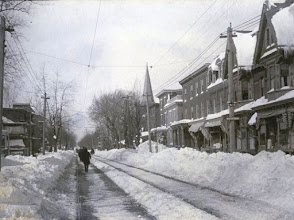Winter '11 / '12 - Arctic Oscillation and Eurasia Snow Cover
The paper detailing the results of the study were published in the 05-NOV-11 issue of Geophysical Research Letters Vol 38.
The "...develop(ment) a snow advance index (SAI) derived from antecedent observed snow cover...explains a large fraction of the variance of the winter AO." The new index follows work relating monthly areal snow cover to NOAM temperatures and the implicit implication for the state of northern annular oscillation modes (AO / NAO). The snow advance index (SAI) is the regression coefficient of the least square fit of the daily Eurasian SCE equatorward of 60°N calculated for the month of October.
Note how the observed AO and surface temperature values for meteorological winter (D-J-F) are correlated in c) above. The positive correlation in the eastern CONUS (red) means when the AO is positive...temperatures are warmer (positive anomalies) and vice versa. When the AO is negative...temperatures are colder (negative anomalies).
A strikingly similar depiction appears in d). Cohen's new snow cover index derived in October is highly correlated (r = 0.86) with temperature anomalies in the eastern CONUS and all but mirrors the observed AO / T correlations during D-J-F.
Cohen and Jones...
"The implications of this discovery are potentially significant. Currently the AO is considered a product of the stochastic behavior of internal atmospheric dynamics and therefore chaotic.Full paper here (.pdf 920 kb).
"The fact that we discovered a single predictive index that explains close to 75% of the variance of the winter AO (though the period is short and the degraded SAI over a longer time period explains less of the AO variance) is inconsistent with this thinking and demonstrates that the AO, while thought to be unpredictable, may in fact be one of the most easily predicted phenomenon known in the climate system. [emphasis added]
"Even the most sophisticated GCMs achieve only marginal skill on the seasonal time scale in the extratropics. Implementation of the SAI in winter seasonal forecasts could potentially be a sea change in operational seasonal forecasts."
Harvey Leonard's (WCVB Boston) interviews with Dr. Cohen here and here.































